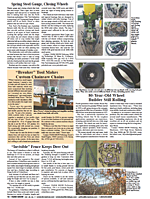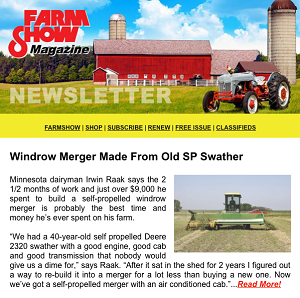You have reached your limit of 3 free stories. A story preview is shown instead.
To view more stories
(If your subscription is current,
click here to Login or Register.)
Red Wine Cap Mushrooms Good For Beginners
Homegrown mushrooms are a delicacy, and few people get the chance to try them firsthand. While the intimidating aspect discourages many gardeners, mushrooms are easier to grow than many vegetables. Even better, a well-established patch will produce for years, and you can select varieties that rarely appear in grocery s
..........
You must sign in, subscribe or renew to see the page.

You must sign in, subscribe or renew to see the flip-book
Red Wine Cap Mushrooms Good For Beginners
Homegrown mushrooms are a delicacy, and few people get the chance to try them firsthand. While the intimidating aspect discourages many gardeners, mushrooms are easier to grow than many vegetables. Even better, a well-established patch will produce for years, and you can select varieties that rarely appear in grocery stores. Red wine caps are an ideal starter—they’re nutrient-rich and among the easiest varieties to cultivate at home.
Red wine caps have a subtle, earthy flavor but are most notable for soaking up sauces and other flavors, especially when used with garlic or red wine. They’re a great source of protein, making up 25% to 34% of dry weight, along with vitamins B and C, and essential minerals like potassium, phosphorus, calcium, manganese, copper, sodium, iron, zinc, magnesium and selenium.
Unlike other culinary mushrooms, red wine caps aren’t picky about their growing substrate. You can inoculate spores on a mixture of agricultural waste, including shredded corn cobs, straw, and both hard and soft wood chips, instead of the hardwood that other varieties require. It’s common for gardeners to plant them along mulched garden paths with established perennials, as the spores need some contact with microflora.
Preparing a mushroom bed requires spawn from a reputable supplier, usually sold in bags of sawdust. Expect a 5-lb. bag to cover about 25 sq. ft. You’ll spread them within a blend of planting materials; clean straw and woodcchips work well together. Look for fresh-cut “green” chips, as decay indicates existing fungi, but that’s hardly a dealbreaker because the red wine caps are a vigorous variety likely to outcompete it.
Soak the planting material for 24 hrs., then let it drain for several more hours. Meanwhile, clear the site of tall weeds and water it well. Cover the soil with an inch of the pre-soaked mixture, and sprinkle handfuls of mushroom spawn on top. Cover with two inches of presoaked material, then water thoroughly before adding more spawn.
Continue this cycle until the mushroom spawn is gone, then cover the bed with a clear plastic sheet. Secure the edges to lock in moisture and leave the bed undisturbed for a month. Then, lift a corner and carefully dig through the wood chips for evidence of white, threadlike growth, called mycelium. If none is present, add more water and leave the sheet undisturbed for several more weeks. Once mycelium appears, remove the plastic and keep the bed moist but not oversaturated.
The timing of the harvest depends on several factors, including planting depth, the type of planting mix, outside temperature and rainfall. A higher concentration of straw helps the mycelium grow faster, leading to quicker mushroom harvests, although production may end sooner. Wood chips, on the other hand, take longer to establish but can produce multiple flushes of mushrooms once they’re ready.
Either way, mushrooms typically appear within a few months to a year. Watch for clusters of red lumps, as this indicates a future harvest. The mushrooms initially emerge with burgundy caps on white stems. As they mature, the red caps enlarge and open, leaving a fleshy, ridged ring on the stem.
Red wine caps are best when harvested small, before the caps have opened. Use a sharp knife to slice them as close to the ground as possible. Alternatively, you can twist and pull the mushrooms from the ground, provided you slice off the stem butt and replant it within the bed to encourage more growth.
The mushrooms will likely spread beyond their original borders, so consider their location carefully. To keep the harvest coming, it’s best to recharge the bed every few years with additional straw and wood chips.
Wine Cap Mushroom Sawdust Spawn can be purchased from retailers like North Spore (www.northspore.com), where it sells for around $30 for 5 1/2 lbs.
To read the rest of this story, download this issue below or click
here to register with your account number.





